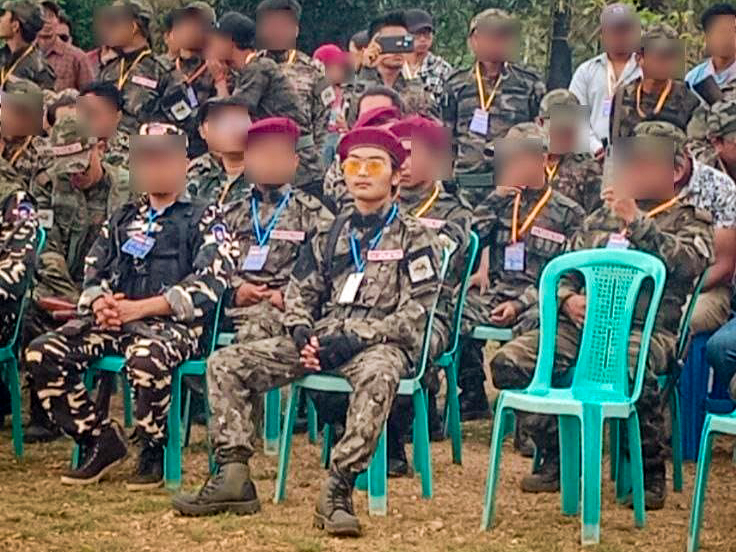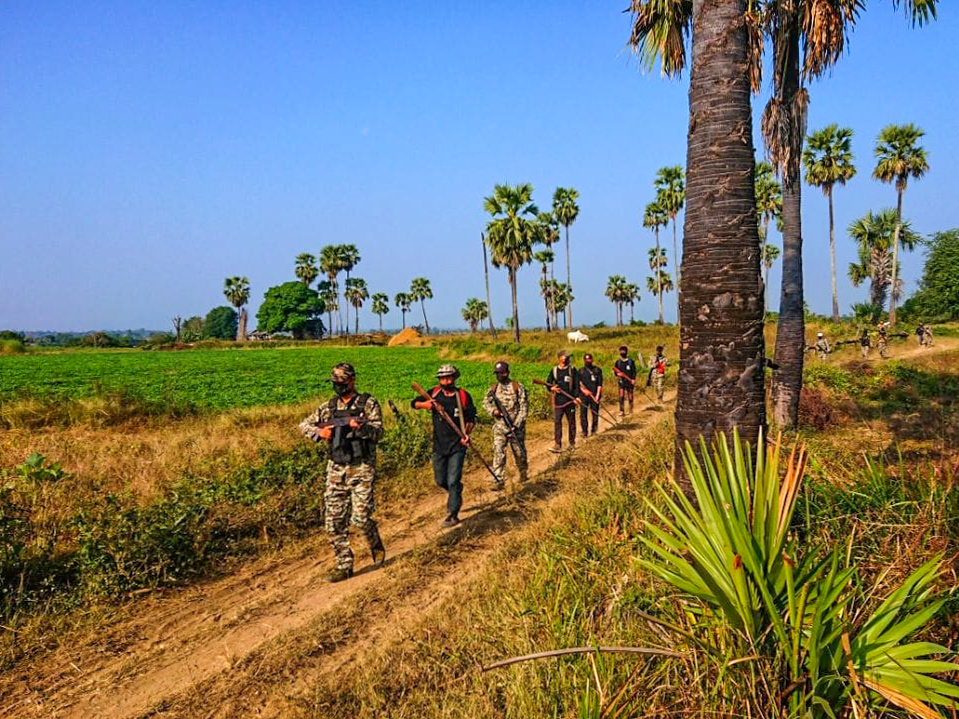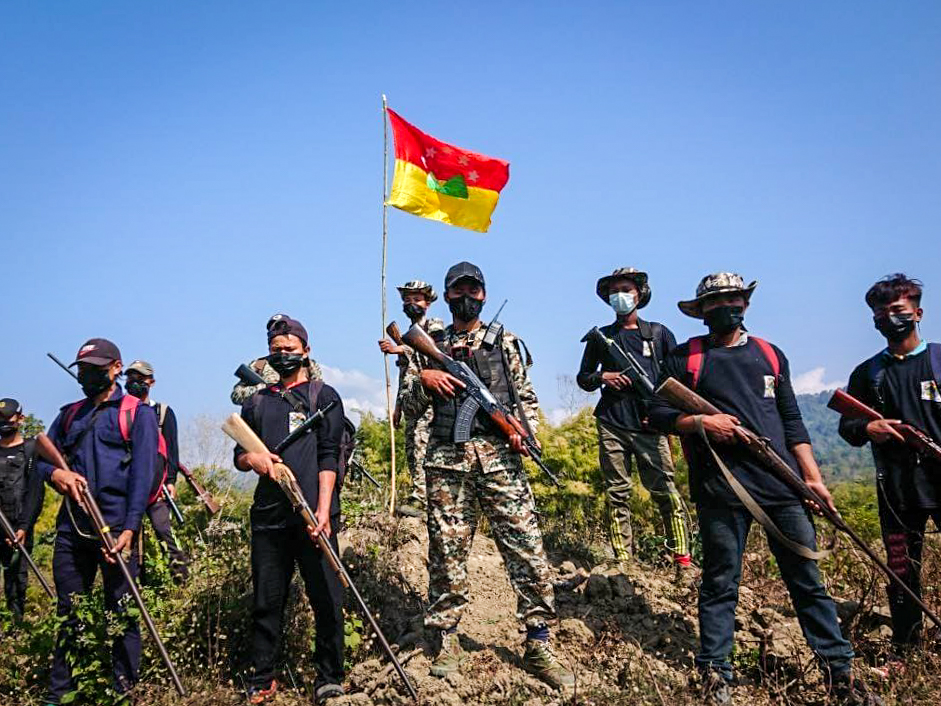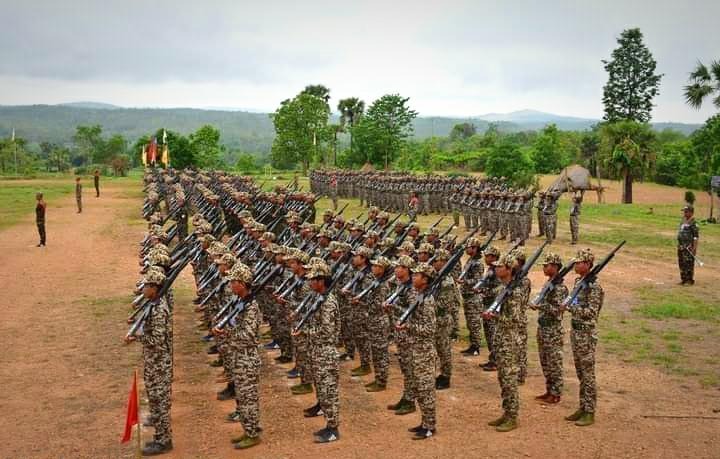Yaw Defense Force (YDF) Deputy Commander Ko Phyo Wai Soe was returning with two comrades from a front-line guerilla operation in Gangaw township when they were ambushed by regime forces on the afternoon of Oct. 9.
The three YDF fighters were riding motorbikes when they encountered a group of eight junta policemen near Kyun Khone Thar village, 40 kilometers north of Gangaw town in Magwe Region — a resistance stronghold. Of the three, only Ko Phyo Wai Soe was armed.
The YDF deputy commander had only his 9 mm pistol as he and his comrades confronted the heavily armed police squad. He was hit in his chest and thigh, while his comrade Pwar Lay was shot in the head. Both died in the firefight. The third resistance fighter, Naing Thein, managed to escape back to base to deliver news of their deaths.
The untimely death of the 21-year-old technological university student-turned-guerrilla leader was a severe blow to fellow YDF fighters and supporters of the armed anti-regime resistance.
YDF Commander Ko Myat Thu said Ko Phyo Wai Soe’s passing was a big loss for the resistance force but also further motivation to uproot Myanmar’s military dictatorship as this was what their deputy commander had fought for.
“His final words were, ‘I do nothing without the consent of the people,’” Ko Myat Thu said.
“We will just try harder to achieve what he wanted.”
‘Outstanding young man’, ‘a person of untold bravery’

At least a dozen local resistance groups, ethnic armed organizations (EAOs) – including the Arakan Army and Chinland Defense Force – and two ministries of the National Unity Government (NUG) have released statements of condolence, praising the YDF deputy commander as “an outstanding young man” and “a person of untold bravery.”
In a condolence letter from the NUG’s Ministry of International Cooperation, Union Minister Dr. Sasa described Ko Phyo Wai Soe as “one of the heroes who sacrificed themselves for the future of the country”, calling his death a big loss not only for the YDF but also for the whole of Myanmar.
The powerful Arakan Army (AA) ethnic armed group described him as a “model” leader in the country’s fight against the junta, commonly known as “Myanmar’s Spring Revolution.” The AA praised him not only for his talent on the battlefield but for leading the push to reopen schools in areas outside of junta control where the YDF operates.
“He was one of the leaders, involved in the revolution since the earliest days. He was decisive and strong-minded in military affairs. I salute him with sadness and praise,” said Ma Grace, platoon commander of the Myaung Women Warriors, a regiment of the Civilian Defense Security Organization Myaung (CDSOM) in Magwe Region.
Known as Ko Phyo by his comrades, the deputy commander not only led troops on the ground but also networked and cooperated with other armed groups, including EAOs, since their early days of operation. He forged friendships with many other armed resistance groups that emerged in the region after the February 2021 coup, and as well as with EAOs that had been fighting military dictatorship for decades.
Rich kid leading fight against brutal junta

YDF is a people’s armed resistance group founded and based in Yaw Territory, Gangaw district, covering the Gangaw, Htilin, Saw and Kyaukhtu townships bordering Chin State. The area is now a hotbed of armed resistance to the junta’s military forces.
YDF is among the area’s largest resistance groups formed since last year’s coup, and now boasts 15 units.
It was founded just days after the Feb. 1 coup by Ko Phyo, Ko Myat Thu and two other Yaw residents.
A university student and the youngest son of a wealthy family, Ko Phyo had a happy life with a bright future until the military takeover. Unlike many rich kids of his age, he loved reading and getting involved in social activities and the student union, his colleagues said.
When street protests against the coup first broke out, he and Ko Myat Thu, three years his senior, organized the rallies in Gangaw.
From the beginning, Ko Phyo believed that only armed struggle could root out military dictatorship. Having made their decision to resist the coup regime, he and Ko Myat Thu immediately traveled to EAO-controlled areas for basic military training.
They returned to Yaw territory a couple of months later, and the YDF was born with support from EAOs in Kachin, Chin and Karen States.
The YDF has offered strong resistance to regime forces in several operations and claims to have killed over 700 junta troops. Ko Phyo was responsible for directing most of the battles on the ground. The Irrawaddy is unable to verify the number of casualties claimed.
Ko Phyo was also the first to smuggle Pakistan-made automatic rifles through regime checkpoints to resistance fighters in Yaw territory. But still faced with a shortage of automatic rifles, he helped produced homemade guns and was working on manufacturing contact-explosion cannons.
But he was constantly at risk of arrest.
In September last year, Ko Phyo was returning from a meeting to buy weapons when he was arrested at a junta outpost.
Police and military personnel found out he was a YDF member and interrogated him. Ko Phyo told them he was merely a subordinate and had no serious information about the resistance group. Three days of torture followed, during which was stabbed in the ears by a screwdriver, beaten all over his body, and had his crushed by bamboo, Ko Myat Thu recalled.
Fortunately, his young age and stoicism convinced his captors he was telling the truth and they released him on parole.
Following his release, he spent one month in hospital. When he had recovered from his torture injuries, he headed straight back to the front line and his YDF comrades.
Escaping peril until the last fight

In February, the YDF joined up with the Myaing People’s Defense Force (Myaing – PDF) to attack a junta outpost in Min Ywar village, Gangaw Township. Though it was described as a police station, the outpost was housing military troops who were waiting for reinforcements before deploying in the area.
Led by Ko Phyo, the resistance operation was a success with at least 20 junta forces killed and about 30 injured.
But when Ko Phyo was hit by a bullet that pierced his jaw, entered his chest and severed an artery, his comrades thought he would die on the spot.
“But though badly injured, he gave a thumbs-up and an order to keep fighting,” said a YDF comrade who was fighting alongside him.
Luckily, he survived the battle and recovered from his wounds.
Ko Phyo recalled the experience in an online speech to mark the YDF’s one-year anniversary in May.

“I was wounded, so our medics rescued me and took me back to the base. My comrades kept fighting for an hour, and we were almost able to capture the station. But reinforcements arrived, so they had to fall back. I still feel regret today about not managing to seize the station,” he said.
Ko Myat Thu said injuries to arteries usually take years to heal but Ko Phyo recovered in just three months after a strict regime of daily exercise and determination.
However, Ko Myat Thu and other leaders urged him to take a back seat and command from behind the lines rather than fighting on the ground.
But he refused and had just resumed front-line action when he was caught in the Oct. 9 ambush with just his 9 mm pistol.
This time there was no escape.
Another who knew Ko Phyo well was Maung Saungkha, commander of the Bamar People’s Liberation Army (BPLA) resistance group. He expressed his sorrow over losing a revolutionary comrade and seeing yet another young life sacrificed in resisting the military regime.
“To achieve our goal, we pay with losses like these. Those of us who remain alive need to keep up the fight to get the genuine federation we expect,” Maung Saungkha told The Irrawaddy, referring to the democratic federal Union that anti-regime forces are fighting for.

















